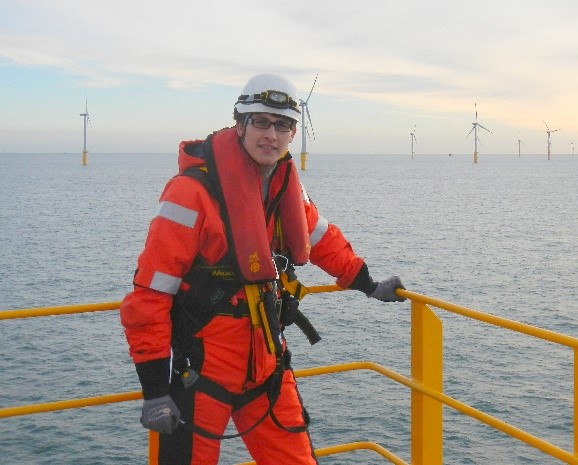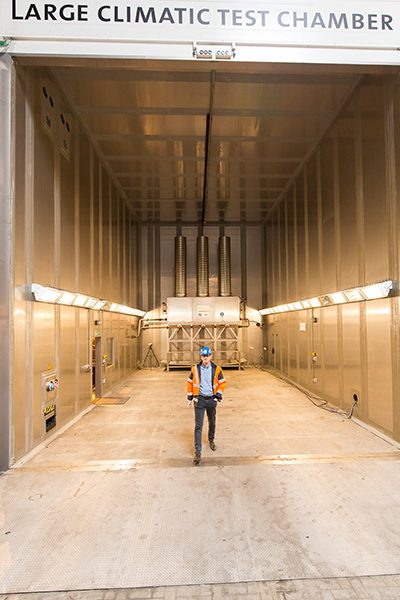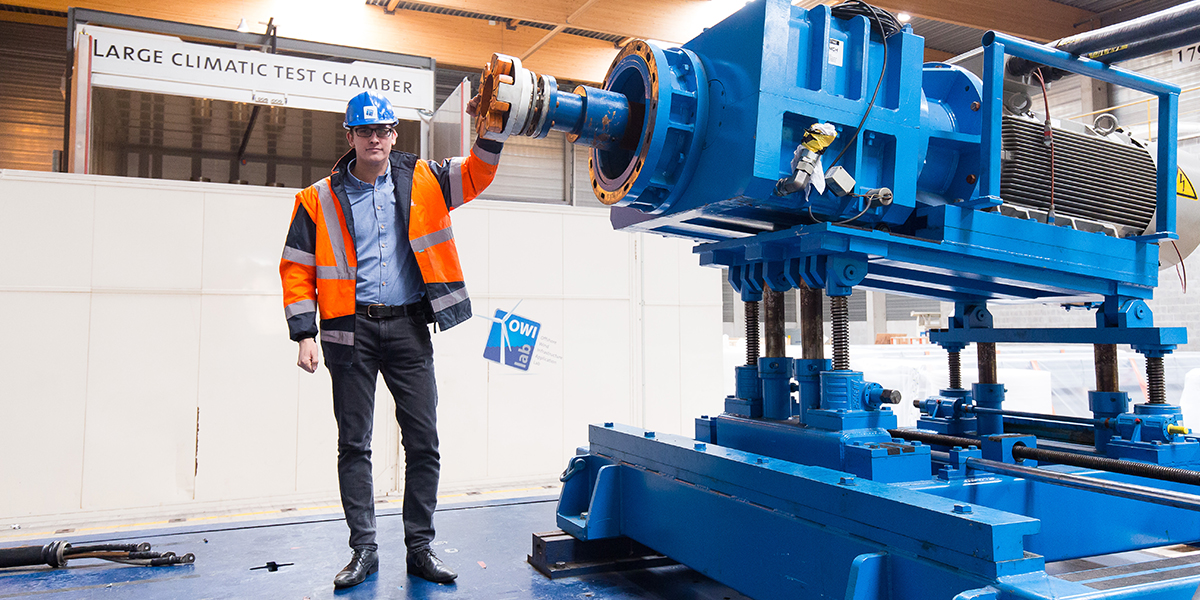8 May 2018
Interview with Pieter Jan Jordaens, Team Leader & Cluster Manager at OWI-Lab

WindEurope visited Pieter-Jan Jordaens at OWI-Lab’s testing facility on the Port of Antwerp. Following a tour of the facility, we had a wide-ranging conversation addressing the role that research and innovation can play in driving wind energy forward.
Can you tell us a little bit about OWI-Lab – what you do, when you began, etc.?
Sure. So, OWI-Lab stands for ‘Offshore Wind Infrastructure Application Lab’ (OWI-Lab). We are a Research Development and Innovation (RD&I) platform based in Belgium. We initiate and support R&D and innovation projects dealing with wind energy. Due to the investment in this testing facility we are often active in wind energy projects located in more extreme environments such as offshore, cold and hot climate conditions because in those projects there are more engineering challenges to tackle. Essentially, we aim to increase the reliability and efficiency of wind turbines and their components. We invested with the support of the Flemish government in some unique testing and measurement equipment to support companies in reaching these goals.
OWI-Lab was set up in 2010 as part of a collaboration with the University of Brussels (VUB) and Sirris. Sirris is the collective centre of the Belgian technology industry; its main function is to support Belgian companies with technology and innovation. We set up and execute RD&I projects with Belgian companies active the Belgian wind energy value chain, sometimes also in a EU-context with our RD&I peers. In 2010, thanks to the support of the Flemish government, a €5.5 million wind energy R&D program was granted with a focus on offshore wind energy. It was initiated and backed by leading companies of the sector like ZF Wind Power, CG Power Systems, DEME-GeoSea and 3E. I started at Sirris in 2010 as project leader of the OWI-Lab initiative.

Where does OWI-Lab fit in to the wind market today?
In wind energy today there is a new niche in which we are active with our climatic testing facility: how do we operate turbine technology in more extreme climates where extreme low temperatures and icing conditions occur? How can we develop and test our machinery to work in hot and cold climates, or humid locations as in the offshore sector? The industry needs cost-effective, validated and robust components capable of withstanding such extreme conditions in certain markets. That’s where we come in.
Standard onshore wind turbines are usually designed to operate in a temperature range from typically -10°C to +40°C. But in locations like Scandinavia, Canada, Inner Mongolia etc. you can get temperatures that drop to -40°C. We are currently preparing even for a -60°C test related to a wind energy project in the North of Russia. In hot regions like the Middle East, you can reach temperatures of up to 55°C or even more, where not only the air temperatures influence the turbines –UV and infrared heat have a significant impact too.
Here at our climatic testing facility in the Port of Antwerp, we have one of the largest climatic test chambers where we test wind turbine components at a range of temperatures and humidity. Our climatic chamber is capable of going from
+60°C to -60°C in approximately one hour. We test mechanical, hydraulic and electrical turbine components, some weighing over 150 tonnes. Everything from gearboxes and transformers to generators and pitch & yaw systems. We also have developed dedicated test benches and methods to cope with the functional testing of such components. Transformers and other electrical equipment, for example, is not only tested for ‘storage’; we also simulate the electrical load, for example, during a start-up at -40°C.
Since the foundation of OWI-Lab, what have been the most exciting changes or developments in the wind industry?
The sheer increase in scale and size for everything. Back in early 2010, when we wrote proposals to apply locally for R&D funding, our benchmark was always to reach a LCOE of €100/MWh for offshore wind by 2020. But if we look at the past two years? (laughs) The market is developing so fast that, immediately, you see that we are approaching €50/MWh, on average. We have all been taken by surprise with the subsidy-free auctions in the Netherlands and Germany.
The speed is really incredible and fascinating – not just in terms of how the market is changing and new markets that kick in, but also in terms of the speed of R&D and innovation that we see in the offshore wind sector. I think we are currently in the moment that ‘it’ is really happening – we are becoming a real industry that is attractive for large scale investments.
On that point – how important is it that you have government support for your initiative?
In every industry you need funding for innovation, and the (offshore) wind industry is no different to that. Our industry has proven that we can cut costs and get industrialised but we are not there yet – there is still a lot of work to be done and we are not yet as mature as other sectors such as the automotive industry. That will still take time and effort in the coming years. Wind turbines onshore and offshore still look the same: they have three-bladed designs and a horizontal axis drivetrain. There is still potential for new types of wind turbines using new technologies such as axial-flux generators, VAWT’s, 2-bladed designs, new foundations etc. Also, with respect to the topic of digitalization there is still R&D work to be done.
R&D and innovation always carries an element of risk, right? There’s the chance that your area of innovation won’t be picked up, that you arrive too early to the market… I mean, you can have a great idea but if the market isn’t ready for it, you’re going to run into serious problems. Belgium has a good example in that, with wind energy. For example, in the eighties, already, we had companies here developing and manufacturing wind turbines. This was an important and serious innovation – but it simply came too early, unfortunately.
But, on the other hand, there were things these companies set in motion which have had a long-term payoff. For example, these companies in the eighties and nineties needed components. And they would go to established companies like the former Hansen Transmissions (now ZF Wind Power) and Pauwels Transfo (now CG Power Systems) for example, and say: “We need a gearbox for a wind turbine application” And at the time, Hansen Transmissions might not have seen wind turbines as a serious business prospect, more like a niche applications compared to the industrial gearbox market. But, down the road, this interaction and built-up knowledge led to ZF Wind Power becoming a world leader in designing and manufacturing wind turbine gearboxes. This came about precisely because you had innovators taking risks. We have similar stories with DEME-GeoSea and Jan De Nul involvements in the construction of the first offshore wind farms in Belgium. Now we see them operating worldwide. It is our ambition to support companies in the full value chain to become world leaders in their wind energy activity.
So what is actually needed is to minimise the level of risk, because this ensures that R&D and innovation will pay off all around. If you have a home market and access to innovation subsidies, your risk is somewhat reduced, of course. For the government it also pays off, as innovation leads to cost reductions and efficiency gains, and employment.
Looking forward, I think we are seeing a shift in where and how we target our innovations. For example, there is huge potential in digitalisation topics – the same applies in other industries, by the way. But proving the worth and value of digitalisation requires investment and funding, and time to learn from datasets.
Let me give a clear example. The topic of structural health monitoring on offshore foundations did not really exist in 2010. Nowadays, its value has been picked up by developers and operators throughout Europe. We can proudly say that we were one of the first on the ground in this area.What happened was this: one of our colleagues from the University of Brussels (VUB), Professor Christof Devriendt, had been working for several years on structural health monitoring topics in the aerospace industry. He involved in vibration and damping tests for plane manufacturers in Europe, so called in-flight flutter testing. But his interest was in applying his research to wind turbine applications like blades and foundations at sea. So we thought: let’s try and adapt his research and apply it to offshore wind, and investigate what value drivers could be found in this case for the offshore wind sector. But you cannot show the value of this innovation without a test or demonstration project, and you cannot do a demonstration project if you don’t have funding and access to test locations. You can do simulations or small scale lab tests, of course, but to prove to companies that the innovations work in-field, it is also important to showcase the added value of this technology will be. Concrete cost reductions, risk mitigation or O&M insights, for example.
We decided to test, monitor and analyse the structural behaviour of certain offshore wind turbine foundations in the Belgian wind farms for a full year, looking at all the potential variables. Maybe the tide level will increase or decrease, maybe the soil conditions will change, etc. By setting up long-term monitoring campaigns, with the support of our Flemish funding agency VLAIO, we demonstrated and analysed datasets, and clearly showed the added value of this data. Some of the insights were even awarded during the previous WindEurope offshore wind conference in London with a best poster award. The bottom line here is that in-field data insights on certain parameters can be very valuable for knowledge build-up to further reduce the LCOE of offshore wind farms. An example of good practice valorisation with this R&D project was the setting up of a spin-off company called 24SEA.

Can you tell us a bit more about your views on integrating insights from other industries to develop wind energy?
I think it’s incredibly useful. Other industries face similar challenges to ours – you don’t have to reinvent the wheel every time you face a challenge. The example above on using modal analysis technology initially developed for aerospace applications tended to be useful for our industry as well. In Belgium, our Flemish Minister for Innovation is setting up clusters where experts in different fields can work together on a particular topic and projects.
Currently we lead an offshore energy innovation cluster together with the University of Ghent (UGent) and the University of Brussels (VUB). Our offshore energy cluster is also being supported towards working together with other clusters –the clusters on drones, for example, and the cluster in composites. And what you see, when you get these clusters talking together, is that although we are in different industrial sectors we are actually very often dealing with similar challenges. Drones need to do inspections on bridges, buildings, etc. But we can use similar technology to inspect our turbine blades. Also, on the topic of composites, for example, we see synergies.
Recently our project CompositeLoop was granted in which our cluster will work together with the cluster on composite material. The project aims at investigating the decommissioning and end-of-life processing of large scale composite structures. In our case this deals with large composite blades, but within the composite cluster other cases are of interest, such as the end-of-life of composite silos, or aerospace structures.
And do you see synergies with other industries that are keen to reduce their carbon footprint?
Absolutely. I have a surprising example for you here: the mining industry! They recognize the amount of cost they pay in transporting and storing diesel at their remote mining sites. The topic of ‘green mining’ is trending in this business field – in which they reduce their carbon footprint but also cut costs. They look at technologies that can help them in reaching these goals.
For example: Enercon has a couple of wind turbines near a mining site in Canada and their turbines are used to produce hydrogen in a demonstration project. This hydrogen is piped into the mines. Also, the mining vehicles themselves are powered electrically and use the hydrogen as an energy source instead of diesel. This means that you don’t have any fumes in the mines; you don’t have to pay for ventilation infrastructure, etc. It also means that you can immediately refuel your mining vehicles inside the mine itself, etc. I think these are promising examples of an integrated approach in which wind energy plays an important role. But again, for these remote cold sites the technology needs to work in extreme cold conditions. That’s where we come in.
Also in the offshore sector we see good practices. Recently our Belgian gas transmission company has set-up a demo-project with Parkwind – one of the Belgian offshore wind developers – on the topic power-to-gas.
This type of synergy is set to grow as we move to a cleaner energy mix.
What developments would you like to see in the wind industry over the next ten years?
If we look high-level, I would like to see a further increase in the reliability of the turbines: zero unforeseen downtime of the machinery is the ultimate aim. This would reduce O&M costs in a major way and, consequently, would yield a higher level of energy production. Integration of storage would be a key thing, too. At this point the reliability and availability have progressed well over the years, so now we need to add solutions in wind turbines or wind farms to continually foresee an energy flow with the right net quality.
But maybe, and I say this more from a business point of view, I’d like to see a further internationalisation of our industry. Onshore wind is already quite international, of course, but offshore is just starting to kick-off globally. We see new markets coming up as the US, Taiwan, Japan etc. But there are other regions that have very long expanses of coastline – Africa, South America, Russia, etc. – which have yet to make the move into offshore wind. The problem is that many such regions are, how to say it… addicted to fossil fuels at the moment. But if we come up with solutions that are appealing to these countries in the long run, that are on a more level playing field with the fossil fuels, then they will also invest in wind energy.
On that note, what does Europe need to do if it wishes to stay competitive with emerging international markets?
I think the first thing is to make sure we don’t lose our home market. Our home market is our testing field, the place where we build up our knowledge in both offshore and onshore wind energy. This still requires support from governments and the European Commission with respect to climate change goals. On the one hand, yes, maybe subsidies can be reduced compared to 10 years ago because the costs have been reduced in recent years. But we still need support for things like getting permits without lengthy delays – because time is also a cost.
Secondly: don’t lose the local manufacturing companies. We know that Europe is more expensive with respect to labour costs, for example. But there could also be other incentives to attract and preserve manufacturing companies. Manufacturing activities are key with respect to knowledge of the application.
Thirdly: with respect to R&D and innovation, we need to ensure that wind energy is heavily on the agenda on a European level. We need testing & demonstration sites, laboratories, access to data, etc. Universities and technology centres need easy access to resources without too much administration if we want to come up with solutions that cope with the demands of our industry.
Finally, we need to build up our knowledge. We have a major lack of engineers and scientific profiles in our industry. We see this in Belgium, for example, there is a big need for engineers in offshore wind. The competences and skills required for this industry are quite specific. We need to start and support Master’s programmes, summer schools, masterclasses and things like that. Universities, governments and industry need to work together on this.
Basically, I am a strong wind energy ‘believer’, so to speak – but we need more believers, people who are motivated and will spread the word about the exciting things that take place in our industry. And we need to communicate this to our young people too so they are willing to work with the biggest rotating machines in the world. They need to be inspired too by what the wind industry is doing and how we move forward – because what we do really is inspiring and game changing.

